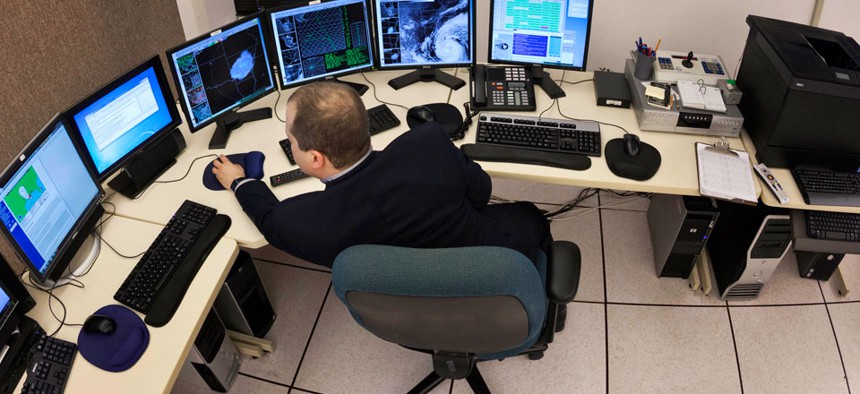NWS Says 'No Involvement' from China-Owned Unit in IBM Supercomputer Deal

Science and operations officer Christopher Buonanno monitors data on Hurricane Isaac at the National Weather Service Warning and Forecast Office in North Little Rock, Ark. Danny Johnston/AP File Photo
The National Weather Service will get forecast-boosting supercomputers that will increase processing capacity by almost tenfold.
Under a new $44.5 million deal with IBM, the National Weather Service will get forecast-boosting supercomputers that will increase processing capacity by almost tenfold. But Big Blue, which spun off its x86 supercomputing business to China-based Lenovo last year, will not be providing the machinery.
Instead, subcontractor Cray will actually build the new servers expected to come online by October. IBM will provide maintenance services for previously installed IBM machines and the new Cray systems, federal officials said Monday.
"IBM will provide maintenance, parts, supplies, etc. on both the existing and new servers," said a spokeswoman at the National Oceanic and Atmospheric Administration, which houses NWS.
When the job is complete, the agency’s two operational supercomputers will reach a combined 5 petaflops – nearly 10 times current operational capacity. The world's most powerful known supercomputer is China's 55-petaflop "Milky Way-2."
Congressional overseers earlier last fall had expressed concerns about Lenovo potentially supplying tainted parts, especially after NOAA in November 2014 confirmed a report that hackers breached weather prediction and satellite systems.
Lawmakers said they were told the Chinese government was behind the intrusion.
On Monday, the agency spokeswoman said there is "no Lenovo involvement" in either current or future supercomputer work.
Government Accountability Office watchdogs welcomed word that the hardware will be built and maintained by American companies, and not by Lenovo.
“Trying to get that simple clarification has just been not easy,” said David Powner, GAO director of information technology management issues.
“The concerns with the recent hacks and even without the recent hacks” created a “potential risk” in the supply chain, he said.
Auditors will review, going forward, whether Lenovo parts and personnel are restricted.
“We’re going to continue to monitor that situation to make sure that in fact is what is going to happen,” Powner said.
This summer, an inspector general report blasted NOAA for overlooking tens of thousands of major cyber vulnerabilities that could let hackers into the nation's environmental satellite operation, called the Joint Polar Satellite System, or JPSS. The IBM machines spun off to Lenovo, x86 servers, are part of that program.
GAO auditors are scheduled to release a new report on JPSS next week that will discuss oversight of system maintenance, Powner said.
JPSS computers aid satellite command and control, and model predictions crucial for aviation, emergency response and other daily activities.
About $25 million earmarked for supercomputing comes from 2013 congressional funding approved in the aftermath of Hurricane Sandy.
Separately, later this month, IBM will triple the capacity of its currently installed NWS machinery to achieve at least 1.5 petaflops, total. That boost will provide the Global Forecast System with more precise resolution for predictions farther out in time. The servers will be leased from and maintained by IBM, not Lenovo, NOAA officials said.
"IBM is proud to continue helping NOAA achieve its vital mission," Anne Altman, general management for IBM Federal, said in a statement. "These capabilities enable NOAA experts and researchers to make forecasts that help inform and protect citizens."
Cray President Peter Ungaro added: “This investment to increase their supercomputing capacity will allow the National Weather Service to both augment current capabilities and run more advanced models. We are honored these forecasts will be prepared using Cray supercomputers.”
The changes are part of a modernization plan that began in July 2013. One already-updated tool, the Hurricane Weather Research and Forecasting, aided the agency during Hurricane Arthur which hit North Carolina in July.






